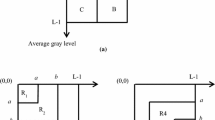Abstract
Purpose
Knowing the early lesion detection of fundus images is very important to prevent blindness, and accurate lesion segmentation can provide doctors with diagnostic evidence. This study proposes a method based on improved Hessian matrix eigenvalue analysis to detect microaneurysms and hemorrhages in the fundus images of diabetic patients.
Methods
A two-step method including identification of lesion candidate regions and classification of candidate regions is adopted. In the first step, the method of eigenvalue analysis based on the improved hessian matrix was applied to enhance the image preprocessed. A dual-threshold method was used for segmentation. Then, blood vessels were gradually removed to obtain the lesion candidate regions. In the second step, all candidates were classified into three categories: microaneurysms, hemorrhages and the others.
Results
The proposed method has achieved a better performance compared with the existing algorithms on accuracy rates. The classification accuracy rates of microaneurysms and hemorrhages obtained by using our method were 94.4% and 94.0%, respectively, while the classification accuracy rates obtained by using Frangi’s filter based on the Hessian matrix to enhance the image were 90.9% and 92.1%.
Conclusion
This study demonstrated a methodology for enhancing images by using eigenvalue analysis based on the improved Hessian matrix and segmentation by using double thresholds. The proposed method is beneficial to improve the detection accuracy of microaneurysms and hemorrhages in fundus images.










Similar content being viewed by others
References
Sidibé D, Sadek I, Mériaudeau F (2015) Discrimination of retinal images containing bright lesions using sparse coded features and SVM. Comput Biol Med 62:175–184
Amin J, Sharif M, Yasmin M, Ali H, Fernandes SL (2017) A method for the detection and classification of diabetic retinopathy using structural predictors of bright lesions. J Comput Sci 19:153–164
Veiga D, Martins N, Ferreira M, Monteiro J (2018) Automatic microaneurysm detection using laws texture masks and support vector machines. Comput Methods Biomech Biomed Eng Imaging Vis 6(4):405–416
Derwin DJ, Selvi ST, Singh OJ (2020) Discrimination of microaneurysm in color retinal images using texture descriptors. SIViP 14(2):369–376
Akram MU, Khalid S, Khan SA (2013) Identification and classification of microaneurysms for early detection of diabetic retinopathy. Pattern Recogn 46(1):107–116
Lachure J, Deorankar AV, Lachure S, Gupta S, Jadhav R (2015) Diabetic retinopathy using morphological operations and machine learning. In: 2015 IEEE international advance computing conference (IACC). IEEE, pp 617–622
Sisodia DS, Nair S, Khobragade P (2017) Diabetic retinal fundus images: preprocessing and feature extraction for early detection of diabetic retinopathy. Biomed Pharmacol J 10(2):615–626
Fleming AD, Philip S, Goatman KA, Olson JA, Sharp PF (2006) Automated microaneurysm detection using local contrast normalization and local vessel detection. IEEE Trans Med Imaging 25(9):1223–1232
Walter T, Massin P, Erginay A, Ordonez R, Jeulin C, Klein JC (2007) Automatic detection of microaneurysms in color fundus images. Med Image Anal 11(6):555–566
Inoue T, Hatanaka Y, Okumura S, Muramatsu C, Fujita H (2013) Automated microaneurysm detection method based on eigenvalue analysis using hessian matrix in retinal fundus images. In: 2013 35th annual international conference of the IEEE engineering in medicine and biology society (EMBC). IEEE, pp 5873–5876
Mazlan N, Yazid H, Arof H, Isa HM (2020) Automated microaneurysms detection and classification using multilevel thresholding and multilayer perceptron. J Med Biol Eng 40:1–15
Frangi AF, Niessen WJ, Vincken KL, Viergever MA (1998). ultiscale vessel enhancement filtering. In: International conference on medical image computing and computer-assisted intervention. Springer, Berlin, Heidelberg, pp 130–137
Srivastava R, Wong DW, Duan L, Liu J, Wong TY (2015) Red lesion detection in retinal fundus images using Frangi-based filters. In: 2015 37th Annual international conference of the IEEE engineering in medicine and biology society (EMBC). IEEE, pp 5663–5666
Zhou L, Li P, Yu Q, Qiao Y, Yang J (2016) Automatic hemorrhage detection in color fundus images based on gradual removal of vascular branches. In: 2016 IEEE international conference on image processing (ICIP). IEEE, pp 399–403
Seoud L, Hurtut T, Chelbi J, Cheriet F, Langlois JP (2015) Red lesion detection using dynamic shape features for diabetic retinopathy screening. IEEE Trans Med Imaging 35(4):1116–1126
Hatanaka Y (2020) Retinopathy analysis based on deep convolution neural network. Adv Exp Med Biol 1213:107–120
Eftekhari N, Pourreza HR, Masoudi M, Ghiasi-Shirazi K, Saeedi E (2019) Microaneurysm detection in fundus images using a two-step convolutional neural network. Biomed Eng Online 18(1):1–16
Chudzik P, Majumdar S, Calivá F, Al-Diri B, Hunter A (2018) Microaneurysm detection using fully convolutional neural networks. Comput Methods Prog Biomed 158:185–192
Porwal P, Pachade S, Kamble R, Kokare M, Deshmukh G, Sahasrabuddhe V, Meriaudeau F (2018) Indian diabetic retinopathy image dataset (IDRiD): a database for diabetic retinopathy screening research. Data 3(3):25
Van Grinsven MJ, van Ginneken B, Hoyng CB, Theelen T, Sánchez CI (2016) Fast convolutional neural network training using selective data sampling: application to hemorrhage detection in color fundus images. IEEE Trans Med Imaging 35(5):1273–1284
Jerman T, Pernuš F, Likar B, Špiclin Ž (2016) Enhancement of vascular structures in 3D and 2D angiographic images. IEEE Trans Med Imaging 35(9):2107–2118
Jerman T, Pernuš F, Likar B, Špiclin Ž (2015) Beyond Frangi: an improved multiscale vesselness filter. In: Medical imaging 2015: image processing, vol 9413. International Society for Optics and Photonics, p 94132A
Otsu N (1979) A threshold selection method from gray-level histograms. IEEE Trans Syst Man Cybern 9(1):62–66
Wu B, Zhu W, Shi F, Zhu S, Chen X (2017) Automatic detection of microaneurysms in retinal fundus images. Comput Med Imaging Graph 55:106–112
Author information
Authors and Affiliations
Corresponding author
Ethics declarations
Conflict of interest
The authors declare that they have no conflict of interest.
Ethical approval
This article does not contain any studies with human participants or animals performed by any of the authors.
Informed consent
This article does not contain patient data.
Additional information
Publisher's Note
Springer Nature remains neutral with regard to jurisdictional claims in published maps and institutional affiliations.
Rights and permissions
About this article
Cite this article
Yang, L., Yan, S. & Xie, Y. Detection of microaneurysms and hemorrhages based on improved Hessian matrix. Int J CARS 16, 883–894 (2021). https://doi.org/10.1007/s11548-021-02358-5
Received:
Accepted:
Published:
Issue Date:
DOI: https://doi.org/10.1007/s11548-021-02358-5




